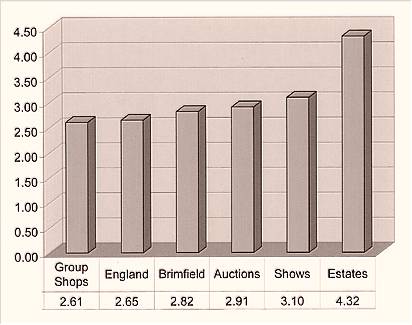The Importance of Professional Buying – Business of Doing Business – The Journal of Antiques and Collectibles – April 2004
By Ed Welch
Contrary to what some may think, dealers make all their money buying. Selling costs additional money and reduces profits. Developing a buying strategy is imperative if the goal of your antique business is to make money. Professional buying is not a lucky find at a flea market. It is not being at the right auction at the right time by happenstance. Professional buying is a result of a carefully thought-out system of guidelines and buying price limits that ensure that a dealer buys only items with the potential to generate profits.
How much markup does a dealer need in order to sustain a viable antique business? The answer depends on the type of business the dealer is trying to maintain. For hobbyists and collector/dealers, a cash-flow ratio of 1 to 2 is sufficient. In other words, every $1 that such a dealer spends on merchandise should generate $2 in sales. For dealers in the trade to make a part-time income, a cash flow ratio of 1 to 3 is necessary. For full-time professional dealers who depend on the antique trade for their entire income, a cash flow ratio of 1 to 4 is necessary, although a cash flow ratio of 1 to 6 is preferred.
The antique trade is divided into 10 levels based on selling price. Level one is the flea market trade. Level 10 is the trade in fine antiques. High profits in the antique trade are most easily achieved at both extremes, level one and level ten. Only in these two levels are cash flow ratios of 1 to 6 possible. If you want to make money in the antiques trade, buy and sell the very best or buy and sell junk.
The most profitable collectible business that I know is run by a husband-and-wife team. They sell nothing priced more than $35. If they happen to buy an item valued more than $35, they call a dealer or place the item in auction. This couple travels between Maine in the summer, Georgia in the spring and fall, and Florida are in the winter. They own a home in Florida that is valued in the high six figures. They own a home on the coast of Maine that is valued about the same. They also own a home in Georgia. They acquired all of this, and much more, selling what most people would call junk.
Their business has a cash flow ratio between 1 to 15 and 1 to 25 depending on how the weekly auctions are doing. It is common for them to buy an item for a dollar and sell that item for $20, a cash flow ratio of 1 to 20. Many items that they sell between $8 and $10 dollars cost them less than a dollar to buy. They save the types of antiques I normally buy to sell to me. In exchange, I sell to them the remnants of estate purchases, cheap. This arrangement has worked out well for both of us.
The high end of the marketplace, as with the low end of the marketplace, offers opportunities to buy at relatively low prices in relationship to value. This is true because few dealers have the working capital necessary to tie up thousands of dollars in inventory operating at the high end.
In the middle range of the antiques marketplace, dealers must settle for a cash flow ratio of 1 to 1 or less. A few dealers are able to manage a cash flow ratio of between 1 to 2 and 1 to 3. Low profit margins at the mid levels of the antique marketplace are the result of too much competition for a limited supply of antiques. This is because many people choose to operate businesses at this level of the trade.The competition for merchandise is so strong that dealers must pay too much for the things they buy. A cash flow ratio of 1 to 1 equals a 50 percent profit on items sold. If a dealer pays $50 to buy an item that sells for $100, only 50 percent of the selling price is profit. Out of the 50 percent profit, a dealer must pay all operating expense and taxes. Generally, the in-your-pocket profit of a 1 to 1 cash flow ratio is measured in pennies not dollars.
I can best illustrate the importance of maintaining a proper cash flow ratio by using a product that everyone will be familiar with: “Basic 4,” a cereal made by General Mills. The selling price of Basic 4 is around $4 a box at Hannaford and Shaw’s supermarkets. The selling price of Basic 4 cereal is $3 a box at Wal-Mart. The difference is a whopping 25 percent. I make a point of traveling to the nearest Wal-Mart at least twice each month to buy Basic 4 cereal.
Contrary to what you may think, I did not choose this illustration to place Hannaford or Shaw’s supermarkets in a bad light. I think it is wonderful that they are able to make an extra 25 percent on every box they sell. I wish that I was able to make an extra 25 percent on every antique that I sell. The fact that Basic 4 cereal can be bought cheaper at Wal-Mart should not surprise anyone. After all, Wal-Mart tells us every day in commercials that they have the lowest price. But if you are a dealer with antiques to sell, or if you are a homeowner with antiques to sell, which selling formula would you prefer. Would you be willing to sell at Wal-Mart prices or do you want to receive the extra 25 percent profit earned by Hannaford and Shaw’s supermarkets?
My preferred cash flow ratio is 1 to 6. To be quite frank, I have achieved this ratio only twice in my 35-year antique career (in 1968 and 2003). However, I have achieved cash flow ratios 1 to 5 and 1 to 4 many times. Had my goals not been set so high, I seriously doubt that I would have been able to sustain a profitable antiques business for so many years.
Each item that I consider buying must past several tests. I consider quality, condition, relevancy with regard to my current inventory, weight, ease of handling, projected resale time, and cash flow ratio. I will pass items of superior quality with proper cash flow ratio if the item is heavy or hard to handle. I will pass quality antiques if the cash flow ratio is lower than that needed to maintain my antiques business. I will pass damaged items unless they are dirt cheap. I will pass quality antiques if they are slow sellers unless they are dirt cheap. All of the these plus a few other considerations equal my buying plan. I never change or alter my buying plan while on a buying trip, especially while attending auctions. I try to keep my buying decisions rational not emotional. I love antiques and the antique trade, I believe that most dealers do. But buying antiques for emotional reasons can put an antique dealer out of business quickly.

The chart that is part of this article is an average of my purchases for five years, 1999 through 2003. (I chose to use to this type of chart, based on a five-year average, because it does not reveal personal financial records of my business. However, the chart is accurate with regard to cash flow ratio for the five methods of buying shown.) As seen in the chart, every dollar I spend at group shops produces $2.61 in sales. Every dollar I spend in England produces $2.65 in sales. Every dollar I spend at Brimfield produces $2.82 in sales. Every dollar I spend at auctions produces $2.91 in sales. Every dollar I spend at antique shows, other than Brimfield, produces $3.10 in sales. Every dollar I spend buying estates and entire collections produces $4.32 in sales.
The difference between income produced by group shop purchases and auction purchases is 30 cents per dollar spent. An extra 30 cents income per dollar spent at auctions is a considerable amount of money. I typically spend $10,000 or more at auctions specializing in the type of antiques I carry.
Buying at Brimfield is less profitable then buying at other shows. My records indicated I buy at prices 20 percent less at Brimfield. However, all my buying competition is at this show. Therefore, the available merchandise is divided into many small pieces. Typically, everything depends on who is the first to visit a given booth.
I have less competition buying at shows other than Brimfield. Therefore, I can leave behind less-than-desirable pieces and concentrate on buying only the best examples. Generally, I can return to an item I have passed, and it is still in the booth. This does not happen at Brimfield, where I am forced by the competition to buy everything I see related to my field when I find it. This reduces my ability to shop for quality.
Every dollar I spend buying estates and entire collections results in sales of $4.32. This method of buying is the most profitable, no secret in the antique trade. Generally, buying several thousand similar items results in a lower cost per item. Because buying entire estates is profitable, I spend much of my buying advertising money soliciting these purchases. I typically buy two estates per year. I am willing to travel anyplace in the world to buy a large collection, and I will travel anyplace in the continental United States to buy an entire estate. I advertise in newspapers, trade publications, and on the Internet to buy entire estates and large collections. I have purchased collections in Prague, Czechoslovakia, Dorsett, England, Los Angeles, Rochester, NY, and throughout New England. On Feb. 19 I flew to Houston, Texas, to look at two major collections of medical-related antiques.
Professional buying is a system, a plan, a set of guidelines developed by a dealer to take the guesswork and the emotion out of the buying process. Spending money is emotional and can be addictive, much like drugs. I have personally seen bidders at auctions get so wrapped up in the bidding process that they lose their ability to rationalize. Spending money at group shops, shows, and in shops while on a buying trip can produce the same highs. It is easy for a dealer to rationalize the purchase of an item, even though that item is less in quality than that dealer usually requires. Subjecting each purchase to a test on quality, relativity, ease of resale, cash flow ratio, and other criteria will lessen the impact of emotions in the buying decision. The result will be an inventory of better quality merchandise purchased at favorable prices.
The figures on the left are dollar amounts, zero to $4.50. The figures along the bottom of the chart are cash flow ratios. Merchandise purchased at group shops generate $2.61 in sales for every dollar spent.
Merchandise purchased in large lots and from buying entire estates generate the most profit, $4.32 for every dollar spent.
-
- Assign a menu in Theme Options > Menus WooCommerce not Found





Related posts: